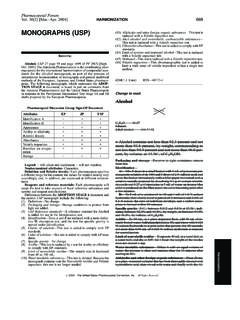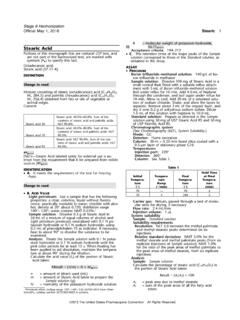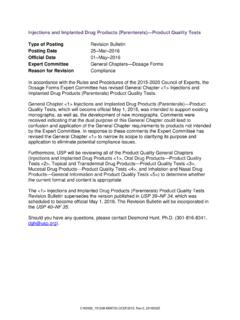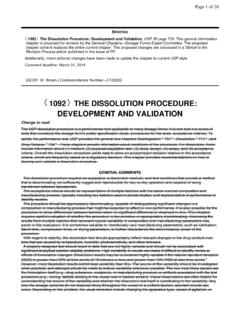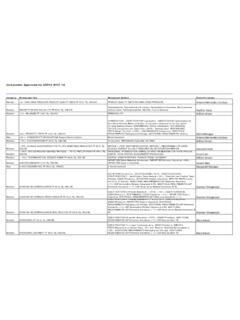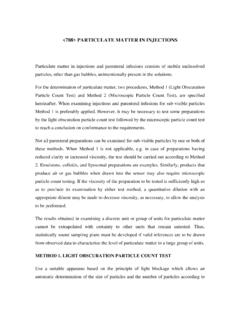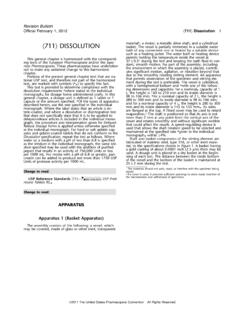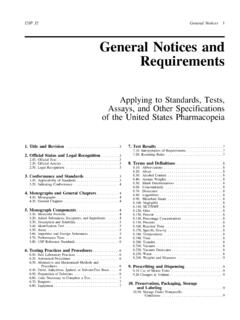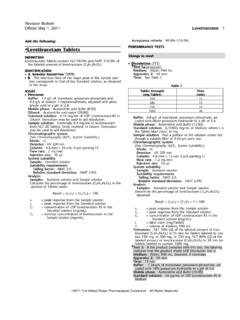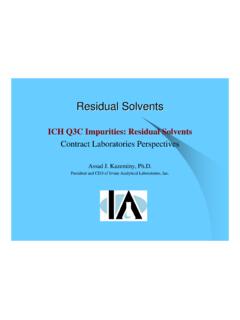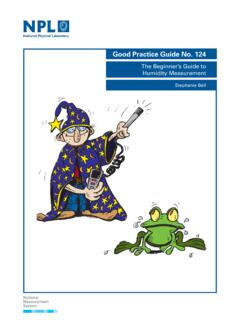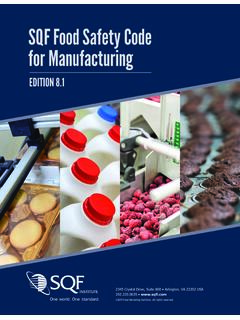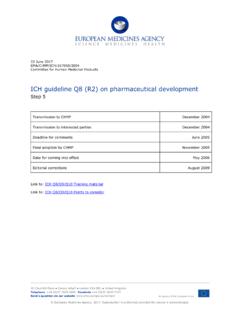Transcription of 467 RESIDUAL SOLVENTS - USP-NF
1 467 RESIDUAL SOLVENTS1. OF RESIDUAL SOLVENTS BY RISK ASSESSMENT3. CONTROL STRATEGY4. LIMITS OF RESIDUAL Class 1: SOLVENTS to Be Class 2: SOLVENTS to Be Class 3: SOLVENTS with Low Toxic Potential5. OPTIONS FOR DESCRIBING LIMITS OF CLASS 2 AND CLASS 3 RESIDUAL Option 1 Concentration Option 2 Summation of Components Content6. REPORTING LEVELS OF RESIDUAL SOLVENTS7. IDENTIFICATION, CONTROL, AND QUANTIFICATION OF RESIDUAL Class 1 and Class 2 RESIDUAL Class 3 RESIDUAL Solvents8. ANALYTICAL PROCEDURES FOR CLASS 1 AND CLASS 2 RESIDUAL Chromatographic Screening of Water-Soluble Screening of Water-Insoluble Limit Tests When SOLVENTS LTBP Are Quantitative Tests Procedure C9.
2 ANALYTICAL PROCEDURES FOR CLASS 3 RESIDUAL SOLVENTSGLOSSARYAPPENDICESA ppendix 1: RESIDUAL SOLVENTS Included in this General ChapterAppendix 2: Additional BackgroundAppendix 3: Procedures for Establishing Exposure LimitsUSP Reference Standards 11 1. INTRODUCTIONFor pharmacopeial purposes, RESIDUAL SOLVENTS in pharmaceuticals are defined as organic volatile chemicals that are used orproduced in the manufacturing of drug substances, excipients, or dietary ingredients, or in the preparation of drug productsor dietary supplement products.
3 Appropriate selection of the solvent for the synthesis of a drug substance or an excipientmay enhance the yield or determine characteristics such as crystal form, purity, and solubility. Therefore, the solvent maysometimes be a critical element in the synthetic process and may not be completely removed by the manufacturing RESIDUAL SOLVENTS do not provide therapeutic benefit, they should be removed, to the extent possible, to meet safety-based limits, ingredient and product specifications, good manufacturing practices.
4 Or other quality-based objective of this general chapter is to define acceptable amounts of RESIDUAL SOLVENTS in pharmaceutical drug productsand dietary supplement products for the safety of the patient. Tests for RESIDUAL SOLVENTS are not generally mentioned inspecific monographs because the SOLVENTS used may vary from one manufacturer to another; however, the limits to beapplied must comply with those specified in this general chapter provides procedures for the analysis of RESIDUAL SOLVENTS , although alternative validated methodologies mayalso be used to demonstrate compliance with the defined limits.
5 For guidance on verification of USP procedures or validationof alternative methods for RESIDUAL SOLVENTS , see RESIDUAL SOLVENTS Verification of Compendial Procedures and Validation ofAlternative Procedures 1467 . This chapter does not address SOLVENTS deliberately used as excipients, nor does it addresssolvates. The limits specified in this chapter do not apply directly to excipients, drug substances, or dietary ingredientsexcept where specified in the individual monographs. However, RESIDUAL solvent levels present in drug substances, excipients,and dietary ingredients may be used to demonstrate compliance as an integral part of the control strategy, thereby reducingor eliminating the need for analysis in the product (see 3.)
6 Control Strategy).Information on RESIDUAL SOLVENTS in coating materials, colorants, flavors, capsules, and imprinting inks is generally notneeded unless Class 1 SOLVENTS are used in the manufacture of these this chapter, the term likely to be present (LTBP) refers to 1) SOLVENTS used or produced in the finalmanufacturing step; 2) SOLVENTS used or produced in earlier manufacturing steps that are not consistently removed by avalidated process; and 3) SOLVENTS properly declared by a validated supplier of a drug substance, excipient, or CLASSIFICATION OF RESIDUAL SOLVENTS BY RISK ASSESSMENTR esidual SOLVENTS assessed in this general chapter are listed in Appendix 1 by common names and structures.
7 USP is alignedwith the International Conference on Harmonisation of Technical Requirements for Registration of Pharmaceuticals forInterim Revision Announcement Official November 1, 2019; Official December 1, 2020 467 1 2019 The United States Pharmacopeial Convention All Rights , rev. 00 20190927 Human Use (ICH) Harmonised Tripartite Guideline for RESIDUAL SOLVENTS Q3C (R5) approach for the classification of residualsolvents (see Appendix 2 for additional details). These SOLVENTS were evaluated for their possible risk to human health andwere placed into one of three classes based on their toxicity data and their environmental impact as shown in Table 1.
8 Classification of RESIDUAL SOLVENTS and Their AssessmentsResidual Solvent ClassesAssessmentClass 1 ( SOLVENTS to be avoided)Known human carcinogensStrongly suspected human carcinogensSolvents particularly known to have ozone-depleting propertiesClass 2 ( SOLVENTS to be limited)Nongenotoxic animal carcinogens or possible causative agents of other irreversible toxicity, such as neu-rotoxicity or teratogenicitySolvents suspected of other significant but reversible toxicitiesClass 3 ( SOLVENTS with low toxic potential) SOLVENTS with low toxic potential to humans; no health-based exposure limit is neededThe limits for Class 2 SOLVENTS are based on the toxicological permitted daily exposure (PDE), calculated as defined inAppendix 3, whereas Class 3 SOLVENTS are considered less toxic, and control to 50 mg/day or less for each of these SOLVENTS isacceptable without justification.
9 The lists in this chapter are not exhaustive and are subject to revision. For SOLVENTS not listed,Appendix 3 may be used to define PDE limits if sufficient toxicological data are available. A flow diagram for potential sourcesof RESIDUAL SOLVENTS in pharmaceutical drug products and dietary supplements is shown in Figure 1. Potential sources of RESIDUAL SOLVENTS in pharmaceutical drug products and dietary are three potential sources of RESIDUAL SOLVENTS in the pharmaceutical drug products and dietary supplementproducts that should be considered (see Figure 1):1.
10 Drug substance or dietary active ingredient Potential solvent sources include their use or formation during the synthesis or purification of the drug substance;their presence in raw materials or reagents used in their synthesis; or degradation of the drug Excipients and/or dietary ingredient Potential solvent sources include their use or formation during the manufacture or purification of Formulation Potential solvent sources are associated with their use or formation during the official product potential presence of other SOLVENTS as impurities in the SOLVENTS used must be taken into consideration in theassessment of SOLVENTS LTBP.
